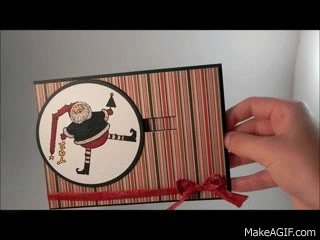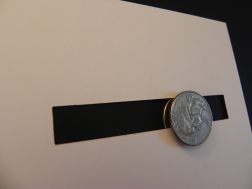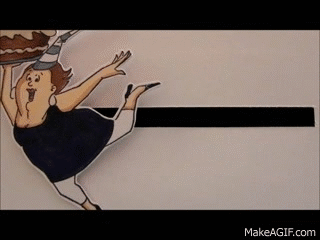Penny Slider/Spinner Tutorial
(click HERE to see original post for this card)
I’ve recently made two penny slider/spinner cards, and I must say, I LOVE watching the elements roll across the cards! (Simple pleasures, right?!) So I figured I’d post a tutorial on how to make one!!
A penny slider card has an element on the card that spins as it travels across the card. It’s called a penny slider card because the spinning element is mounted on a “sandwich” of two pennies with a pop dot in the center which rolls across the card in a slot or channel that you create on the front of your card.
(click HERE to see orignal post for this card)
There are three basic parts to a penny slider card: the element that slides/spins, the channel or slot it spins across, and the card front itself.
1. To make the sliding/spinning element:
For this step, you need: 2 pennies, a round foam pop dot, glue dots and the thing you want to spin across your card.
a. Choose an image or element. Stamped images either cut out or stamped on a basic shape work well. Small, 3-D objects like flowers work well also. Whatever you decide to use needs to be larger than a penny (or whatever coin you plan to use to create your spinner) so the penny will be hidden when the card is assembled. (I am going to use the birthday gal image by Art Impressions (Hampton Art) # PS0919 for the rest of my tutorial.)

b. Create half the penny “sandwich” by adhering a round, foam pop dot to the CENTER of one penny. The size of the pop dot does not matter as long as it is smaller than the coin.
c. Adhere the image or element to the other side of the penny with glue dots. Try to make sure the penny is centered on the back of your element.
d. I’d wait to do this final step until after you create your channel (see section 3), but the final step to create your penny “sandwich” is to attach a second penny to the other side of the pop dot. Once done, the pop dot will be “sandwiched between two pennies, and this “sandwich” will be attached to the back of your image/element.
2. Design your card front:
This is the step that requires little explanation since anything goes! Just plan your card front to incorporate the spinning element you created in the section above. I suggest using a heavy weight card stock for this panel (either by itself or mounted behind a piece of patterned paper) since you need it to be somewhat sturdy. A flimsy card front will bend slightly and cause the spinner to get stuck as it travels. (For this tutorial, I am using a plain, white piece of card stock. Pretend it is decorated beautifully!!)
3. To create the channel across the front of your card:
For this step, you need a cutting tool (like scissors, a craft knife, a die or a trimmer) to create the channel/slot.
a. This slot can either be hand-cut, die cut, or created with an electronic die cutting machine. The slot can be as long/short as you desire. To prevent the spinning element from hanging over the edges of your card when it gets all the way to the right or left, place your element upside down and note where the pop dot on the penny needs to stop in order for the element to stay within the boundaries of the card. (Check all possible directions of the element.) This will give you an idea of how long to make your channel. (The element will stop spinning to the left when the left side of the foam pop dot hits the left edge of the channel. The dashed line on the card stock shows where the channel should end based on where the foam pop dot is for this particular element.)
So the yellow highlighted line (below) shows a good length for the channel. Anything shorter is fine; there will just be less room for your spinner to spin. Anything longer will allow the spinning element to hang off the card (which is fine if you are ok with that!).
b. To determine how wide to make the channel, look at the pop dot and coins you chose to use. Your slot needs to be just slightly larger than the diameter of the pop dot and smaller than the distance from the edge of your coin to the opposite edge of the pop dot. You want the pop dot to be able to spin freely in the channel, but you don’t want the sandwich to fall out of the slot once it is inserted.
In the photo above, the line represents the bottom of the channel or slot on which the pop dot will sit/roll. The little arrow shows a good place to cut the top of the channel because it is above the pop dot but below the top of the coin.
This is a good width. The penny sandwich can move freely but won’t fall out.
The slot below is too wide. The penny sandwich can move freely, but the coin is not big enough to stay in the slot.
To fix this, you can use a larger coin, a larger pop dot, (or cut a more narrow channel/slot).
4. Assembly:
For this step, you need pop dots or foam tape.
a. If you still need to finish the penny sandwich, you can do that now by attaching the second penny to the foam pop dot directly over the first penny.
b. Carefully insert the back penny in the slot by pushing the slot open slightly with your fingers. Once in, it should not fall out. (Again – If the element does not spin freely, your slot needs to be wider. If the element falls out of the slot as it spins, your slot is too wide. To fix this, use a larger coin or larger pop dot.)
c. Once your card front is complete with the spinner element inserted in the slot, it’s time to adhere it to the card base. This panel needs to be raised to allow the penny sandwich to roll freely so use pop dots or foam tape. On the back of the card front panel, place the foam tape or pop dots around the channel (without touching the penny) as shown below, and also place foam tape around the edges of the panel (not shown). You may need to double up the foam tape or pop dots to raise the panel enough so the card base does not come in contact with pennies.
c. Attach this panel to your card base, and enjoy!
This tutorial is being featured over at Die Cut Divas this month where I was invited to be a guest designer. They have monthly challenges where all cards/projects must be made using at least one die cut or embossing folder, and this month’s challenge is Your Favourite Holiday. (Click HERE to see all the challenge rules.) Pop on over to Die Cut Divas and share your holiday projects. I can’t wait to see what you create!
Thanks for checking out my post!























What a cute spinner card. You make the most wonderful action type of cards. I usually don’t have that much ambition but they are really cool and perhaps I better try them again.
LikeLike
Very creative & fun!
LikeLike
Lisa, I love your spinner cards. The ball going between the penguins is too cute and the santa and lady doing cartwheels makes me laugh.
LikeLike
A perfectly clear and easy to follow lesson to build a creative and fun card that anyone would want to build themselves!
LikeLike
Pingback: Tropical Penguins – Penny Slider Card | I Played With Paper Today!
Pingback: Build a Snowman – Birthday Challenge #5 | I Played With Paper Today!